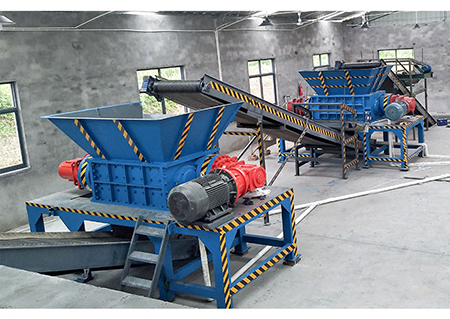
Tel/Whatsapp:+86 15649675999
Email:sale@kowloonmachine.com

Tel/Whatsapp:+86 15649675999
Email:sale@kowloonmachine.com
Article published:2024-04-15
How long can solid waste be used as alternative fuel?
Since the second half of last year, the number of inquiries about alternative fuels from new and old customers has been increasing day by day. Projects that originally used dual-shaft shredders for pre-shredding have been upgraded and all have to be resourced and commercialized. Now, more than a year later, different voices have appeared in the market. For example, "This is a policy-oriented market, and it will no longer work in the future", "It is difficult to collect materials, and the processed products are not easy to sell", "The equipment is unstable and production is stopped every three days", etc. So, how long can solid waste be used as alternative fuel?
In the past two years, the introduction of a series of guiding documents such as "green ecological civilization construction", "double carbon" goals, the "14th Five-Year Plan", "waste-free cities", CCER, Beautiful China, etc. have pushed waste treatment and clean energy to the forefront On the cusp of the storm. In the field of solid waste treatment, turning domestic waste, industrial waste, construction waste, agricultural and forestry waste into useful resources has become a key direction. As a result, alternative fuels have become the “chosen one” at this stage.
Alternative fuel is to separate the combustible materials from solid waste, and after processing, it can be used as fuel to replace coal by power plants, cement plants, steel plants, etc. Alternative fuels have many significant advantages compared with coal, such as wide sources, low pollution, low carbon emissions, low prices, etc. They have a long development process abroad and the technology has matured, so they have quickly emerged in the domestic market. Explosive trend.

However, there was a cooling-off period after the outbreak, and the consequences of the blind entry began to appear, which is why there were so many "different voices" as we mentioned above.
Alternative fuel processing requires dual-shaft shredders, single-shaft fine shredders and even RDF forming machines. It is necessary to flexibly select disposal processes and equipment based on local solid waste conditions and the conditions of the receiving unit. For example, local domestic waste is locked up by the franchise of large power plants, and there are no cement plants or other units that receive alternative fuels, so the alternative fuels produced have nowhere to sell. In the early stage, the price is high and the supply is less than the demand. The price can still take into account the transportation costs, but it will be difficult in the later stage. This is the sequelae of not planning well in the early stage. Therefore, when we encounter customer inquiries now, we will first understand the other party's material sources and sales direction, recommend reasonable processes based on the actual situation, leave enough space and alternatives for long-term operations, and be responsible to the customer.
As for how long solid waste can be used as alternative fuel, we can refer to the development process abroad. In the 1970s, the concept of alternative fuels emerged and entered the exploration and application stage. Today, half a century has passed. Among the carbon neutrality goals of various countries in the Paris Agreement, the carbon reduction commitments of developed countries are still to increase the replacement rate of alternative fuels. Some should reach 90%, and some should reach 50%. , while my country’s replacement rate is 2%. It can be seen that there is still a long way to go before the popularization and application of alternative fuels in our country. It is still too early to worry about its future market.
It’s not that simple to use industrial waste as alternative fuel
Industrial waste was originally something that companies tried their best to dispose of. The main methods of disposal include: selling useful waste for scrap, paying others to take away useless waste, throwing it into the trash can as domestic waste, secretly dumping it, etc. After processing and processing, the national requirements are strict and we cannot throw them away casually, so I asked the waste collector to pick them out first, and spend money to secretly dispose of the rest. This concept is deeply rooted in the hearts of the people. Until the past two years, industrial waste can be sold directly for money, and some companies have been fined for mixing industrial waste into domestic waste. This shows that companies still have a long way to go to standardize the treatment of industrial waste.
Since the implementation of the "double carbon" target, large energy consumers such as power plants, cement plants, and paper mills have faced pressure to reduce coal burning. In addition, the carbon quota system must be implemented. Reducing carbon emissions means visible savings. Excessive emissions require spending money, which has led many companies to incinerate industrial waste instead of coal.
Industrial waste contains many combustible materials, such as cloth, leather, paper, plastics and their various mixtures. The calorific value of some materials is higher than thermal coal. Therefore, it has been actively welcomed by the alternative fuel market. A batch of industrial waste purchases , projects for independent processing of alternative fuels have been implemented one after another, truly turning "waste into treasure" from advocacy to market demand.
The "turning waste into treasure" of industrial waste is to shred and screen different types of industrial waste through various processing procedures, and finally mix different materials in different proportions to meet the standards of market demand. Became a commercialized alternative fuel. The processing of alternative fuels requires the selection of different process combinations based on the different characteristics of the original industrial waste, and the price of the final product will also be quite different. According to market acquisition standards, calorific value, moisture content, chlorine content, sulfur content, etc. are the main factors that determine the price, so corresponding avoidance measures need to be taken in the early stage.